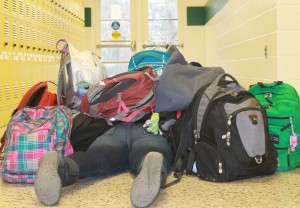
Heavy book bags may cause negative effects on high school students’ bodies. Studies have shown that students are recommended to only carry 5-10 percent of their body weight in a book bag, but many of Northwood’s student body carry more than that.
Out of 30 book bags weighed, the average weight was 19.2 pounds. If that number were 5 percent of a student’s body weight, then that would mean that the average high school student would weigh 384 pounds. If the bag represents 10 percent of body weight, the average high school student would weigh 192 pounds.
“I think my book bag may make up about one fourth of my weight and I don’t think that you should have to carry that much weight around for hours a week,” junior Austin Vohwinkel said.
The majority of students surveyed think that heavy book bags can cause long-lasting back problems, but most are not sure if it is really true.
“I think backpacks cause back problems because of the heavy stress it puts on teenagers’ shoulders and backs,” senior Abigail Waite said.
According to science teacher Sarah Robertson, it is true.
“There have been studies showing that the kids are carrying much more than the recommended weight on their backs,” Robertson said. “If you look at six year olds coming home from kindergarten with their backpacks that are giant on their itty-bitty frames, some of them are carrying about 50 percent of their body weight. That can cause back issues later on in life if we don’t come up with a way to ameliorate [fix] this problem.”
In a poll of students, the average number of textbooks carried in a book bag on a daily basis was between one and two, and the average number of binders was two. The average textbook weighs between three and five pounds. Throw in two of those, a laptop, charger, calculator, binders and whatever else the average high school student needs, and it really adds up.
Some students make the argument that the e-textbooks are better because they take up less space, give them less to keep up with and are more convenient.
“Laptops make it easier with the textbooks online, but when the books aren’t online and we have to carry them and the laptops, too; it’s just a hassle,” senior Whitney Howerton said.
Many students prefer the laptops, but the school may be unwilling to give up textbooks completely.
“Studies have shown that students who are reading actual textbooks and manually flipping the pages retain information a lot better than they do from reading online,” Robertson said.
Some teachers, like Robertson, still favor the physical textbooks.
“It definitely does lighten their load because they can carry four textbooks in the space of a laptop, but it’s not a complete substitute for reading. It’s great for weight, but not necessarily for retaining information,” Robertson said.
The main issue is whether a student would rather have a better understanding of what they have learned or have a healthy back.
Robertson and a few others, like English teacher Lisa DeLorenzo, are allowing students to check out a textbook and leave it at home. They then use the e-textbooks or another set of textbooks in class. It saves the students’ backs and still allows them to get the full benefit of manually reading through the textbooks.
“If we’re going to be working on things in class, I realize that I don’t want them to be carrying huge amounts of weight on their back and there’s only so much room in classrooms,” Robertson said. “Class sizes are getting bigger and backpacks take up the room of a student. I’d say that we should use our e-textbook when in class, but for learning purposes use the real textbook at home, then leave it there.”
— By Kasey Jenkins
